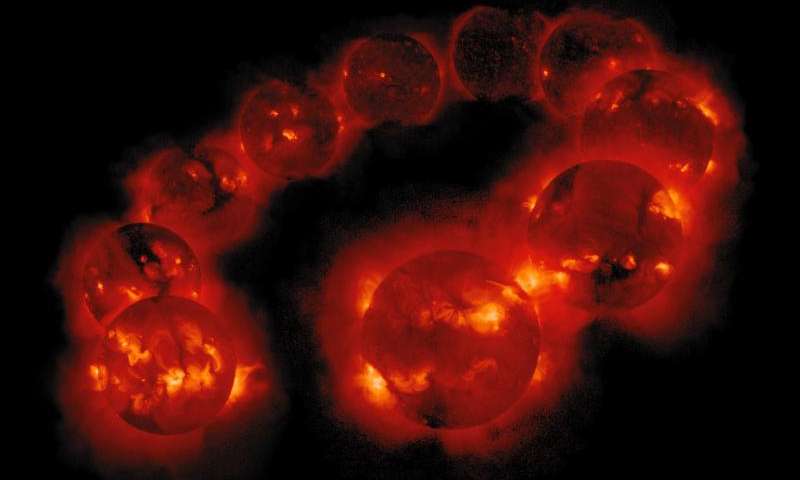
Beginning in about 1645, the Maunder minimum corresponded with the severest portion of the last "Little Ice Age."
Results of the new study were to be presented yesterday by Prof Valentina Zharkova at the National Astronomy Meeting in Llandudno.
Many solar physicists think the solar cycle is driven by a dynamo caused by convecting fluid deep within the Sun. However, when Zharkova and her colleagues added a second dynamo close to the surface, they found that it completed the picture with unprecedented accuracy.
"Our predictions showed an accuracy of 97%," said Zharkova.
The model predicts that the waves from the two dynamos will become increasingly offset during Cycle 25, which peaks in 2022. During Cycle 26, from about 2030 to 2040, the two waves will become exactly out of synch, leading to a significant reduction in solar activity.
"In cycle 26, the two waves exactly mirror each other - peaking at the same time but in opposite hemispheres of the Sun. Their interaction will be disruptive, or they will nearly cancel each other. We predict that this will lead to the properties of a 'Maunder minimum'," said Zharkova.
"Effectively, when the waves are approximately in phase, they can show strong interaction, or resonance, and we have strong solar activity. When they are out of phase, we have solar minimums. When there is full phase separation, we have the conditions last seen during the Maunder minimum, 370 years ago."
In other words, we should expect continued deterioration in global climatic conditions between now and 2022, at the peak of Cycle 25.
That's only seven years away!
Then it will get worse.
We will be praying for global warming.
Read entire article here.



Reader Comments
Your bias is showing again. The article CLEARLY says:
Zharkova and her colleagues derived their model using a technique called 'principal component analysis' of the magnetic field observations from the Wilcox Solar Observatory in California. They examined three solar cycles-worth of magnetic field activity, covering the period from 1976-2008. In addition, they compared their predictions to average sunspot numbers, another strong marker of solar activity. All the predictions and observations were closely matched.
See - MAGNETIC FIELD, NOT SOLAR ACTIVITY as you incorrectly state.
Three sources shoot down your misread enough that you should apologize to your readers for misinterpretation.
From Nature Bats Last, Guy McPherson, arguing with RE from Doomstead Diner (who failed to catch the mistake)
Guy McPherson Says:
July 13th, 2015 at 4:00 pm
RE, your ignorance knows no bounds. If you’d done a little research, you’ve have discovered a few tidbits about that cute feedback of yours:
The clathrate gun has been fired. There is no way the proposed mini ice age will significantly slow the heating.
Every report I’ve read about this study misquotes it. Solar *magnetic* activity was evaluated. Media reports are claiming solar *intensity* will decline.
The anticipated 60% reduction in solar magnetic-cycle magnitude translates to a climate forcing of -0.1 W/m2. That’s equivalent to a decrease of 8 ppm atmospheric carbon dioxide. The atmosphere currently holds about 400 ppm CO2, with 350 ppm ultimately lethal to humans. Subtracting 8 ppm at this point is analogous to giving a blood transfusion to a dead man.
Or you could read this. Even Joe Romm figured out this one.
Then we go to the article he refers to by Romm:
Media Reports The World Will Enter A ‘Mini Ice Age’ In The 2030’s. The Reverse Is True.
[Link]
[begins]
U.K. tabloids, conservative media, and others are (mis)reporting that the Earth will enter a “mini ice age” in the 2030s. In fact, not only is the story wrong, the reverse is actually true.
[read the whole article]
Lastly, a few years ago in Skeptical Science (Posted on 14 August 2013 ):
A grand solar minimum would barely make a dent in human-caused global warming
[Link]
Recent articles in the Danish newspaper Jyllands-Posten (translation available here) and in the Irish Times both ran headlines claiming that another grand solar minimum could potentially trigger an "ice age" or "mini ice age" this century. These articles actually refer to the Little Ice Age (LIA) – a period about 500 to 150 years ago when global surface temperatures were about 1°C colder than they are today.
Thus a grand solar minimum would have to cause about 1°C cooling, plus it would have to offset the continued human-caused global warming between 1 and 5°C by 2100, depending on how our greenhouse gas emissions change over the next century. Though in the Jyllands-Posten article, Henrik Svensmark (the main proponent of the galactic cosmic ray-climate hypothesis) was a bit more measured, suggesting,
"I can imagine that it will become 0.2°C colder. I would be surprised if it became 1–2°C"
So these two articles are suggesting that a grand solar minimum could have a cooling effect of about 1 to 6°C, depending on how human greenhouse gas emissions change over the next century. Is it plausible that a grand solar minimum could make that happen?
The short answer is, 'No.'
Please stop with the agenda - it really damages your credibility. Report the facts, we can figure it out on our own.